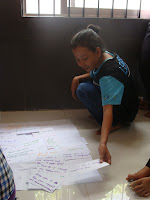With the seven teachers at Soksan International School we brainstormed what we wanted the students to learn under the umbrella idea of 'Who We Are'. All ideas were written on separate pieces of paper so they could be moved around later.
Having brainstormed, we grouped similar ideas and found we had four large concepts or learning areas.
Who Am I?
Society and Culture (This was huge - and we decided should be a unit on its own)
How do I Learn?
Health and Hygiene (Digestive system, Oral Hygiene and Diet)



We also wanted to include Vegetable Gardening and Business Skills to meet the needs of the students and resources of the community.
We then created a mind-map to show the five different learning areas.
Each main branch is a large learning area, and the twigs coming off them is what we want the students to learn. We used this mind-map to write a 12 week long Unit Plan together. It proved to be very helpful as it showed the BIG IDEAS and WHAT we wanted to teach. Basically all that was left was HOW we were going to teach and what exactly the students would be doing while learning.









